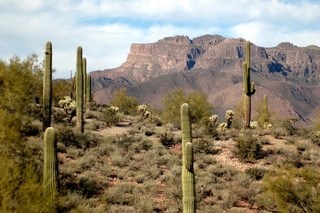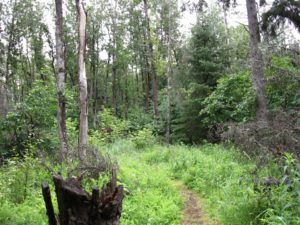
If you’ve followed the blog for any amount of time you know that we’re passionate about survival, and Shane in particular really loves the bushcraft and wilderness survival/primitive skill area of outdoor adventures. So when he received a really good looking pitch on how you can build everything you need for camping or surviving in the wild, he was all about that!
With that in mind, we won’t waste any more time on an introduction. The long introduction is like string beans, and the rest of this post is the true meat and potatoes.
Thanks again to Nigel for this fantastic guest post that campers, outdoor enthusiasts, and bushcraft specialists alike will enjoy.
So, Nigel, take it away!
Table of Contents
You Can Build Everything Needed for Camping
Camping is one of the simplest pleasures and one of the most affordable ways to go on vacation. You’ve likely noticed that camping has had something of a resurgence lately; there are many reasons for this. One of them is the amount of money you can save when on vacation. However, you’ve likely also noticed that there is an entire industry around camping. There are dozens of different companies and incredibly specialized tools.
Every company insists that its specific tool is absolutely essential for your camping experience. That’s simply not true. In fact, with a few specific tools, you can build everything you need for your camping trip. If you want to go back to basics and travel as light as possible, here are a few things you need to do.
Where You Are Going?
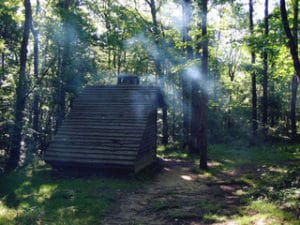
When you are planning your minimalist camping trip, you need to be thinking like a survivalist. A survivalist is someone who plans and practices for situations in which the modern amenities are no longer available. In these scenarios, one must rely on their knowledge and their expertise to survive in rough terrain. All of the survivalist skills will translate well to minimalist camping as well.
The first thing you need to consider is where you are going to be camping; that will determine how you can acquire the things you need. However, the things you need will stay the same no matter where you go. You will need water, food, and shelter. Finding those things can be very difficult in some terrains and easier in others.
Typically, survival is broken down into the “rule of threes.” According to this adage, you can survive three minutes without air, three hours without shelter, three days without water, and three weeks without food. Those are not hard and fast rules, but they do provide a good general guideline for your priorities.
When to go is also a consideration. If you can avoid it you want to avoid extremes of temperature or rain. Weather extremes are bad enough when you have everything you need for every situation let alone when you need to build everything you need in the field.
Once you have determined where you are going to go, you will be able to determine how best to plan ahead.
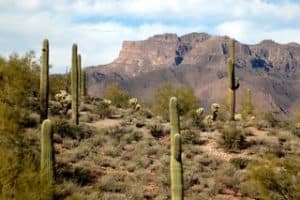
For Dry Climates
If you are going to a dry climate such as a prairie or a desert, your concerns are still going to be shelter, water, and food. The shelter will keep the harsh sun off of you during the day and keep you warm at night. Dry climates get surprisingly cold overnight; a shelter is absolutely essential. Finding water is important as well.
If you’re camping next to a stream or a creek, you will only need something to hold the water and something to clean the water. That’s why the first thing you pack should be a hatchet or an ax. You can check out this guide to determine whether a hatchet or an ax would be more useful for your bush craft needs. They each have advantages and disadvantages.
In general, if you are going to be doing a lot of walking around, a hatchet will be lighter weight and easier to carry. If you need to do any heavy chopping, an ax would be more efficient. Since dry climates tend to have shrubs and bushes with very few tall trees, you likely won’t need an ax.
So, if you find yourself in a dry climate with just your hatchet or ax, you need to build a shelter. Normally, there are rock outcroppings or dry river beds that could serve as shelter. One of the best ways to find a shelter when you’re roughing it is to find one that’s already available to you. If you can find a large boulder or tree, that could serve as one of the walls for your shelter.
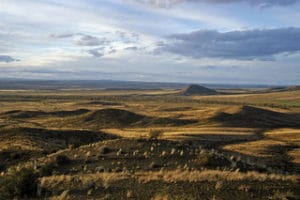
You should figure out which way the wind is blowing, so that you can build your shelter in the lee. A lean-to is probably the simplest structure you can build with a hatchet or an ax. To build a lean-to, you will use your ax to cut branches. You should attempt to cut branches about the same length.
If you can’t find a natural structure such as a rock to serve as a wall for your lean-to, you’ll need to construct one. Stick two branches into the ground vertically with a cross-bar lying across them. Then, you lean the other branches against that cross-bar at a 45 degree angle.
Make sure you get the branches as close together as possible or your lean-to will leak. Alternately, you can use something you brought with you. Rain is not as much of a concern in dry climates, but a poncho is a great thing to bring with you. If you don’t bring a poncho, a mylar survival blanket is a great choice. (Read about emergency blankets here)
Either one of these would make a great roof for your lean-to. You simply need to erect vertical branches or find somewhere to attach your poncho or blanket. Attach the blanket, stretch it to the ground, and secure it to the ground. This type of lean-to can go up in minutes even if you don’t have much wood available.
Once you’ve built your shelter, you need to find water. If you brought water with you, that’s not a concern. However, the idea is to build as much as possible yourself while camping. If you’re in an incredibly dry climate like a desert, you can actually find water by cutting into cacti. Cacti and other succulents can collect incredible amounts of water.
This is another thing for which your hatchet or ax is useful. One major caveat is that some cacti can actually be poisonous. If you don’t have a book of local flora, don’t risk a cacti.
Another way to find water would be to follow signs of life. If you see animals, even small animals, moving around, you can follow them. They are likely headed to or from a source of water. They probably have their shelters near a source of water as well. In the morning and the evening, birds usually circle over sources of water; look out for them. Lastly, you can use any waterproof sheet, such as your poncho, to collect condensation.
To collect water with your poncho, you need to use your hatchet to dig a hole a few feet deep. Put a can, leaf, or whatever can hold water in the middle of the hole. Stretch your poncho over the hole and anchor it down with something heavy.
Finally, put a stone right in the middle of the poncho over the can, so that the poncho sags towards the can. As the temperature changes from day to night, water will condense on the underside of the poncho and drip into the can.
Dry Climate Summary
So, in summary, for a dry climate, you camp with just a hatchet or an ax. You also need enough wood to build a lean-to but that can be found where you are. If you are not going to have enough wood to build a lean-to, you should bring a poncho or a mylar blanket. These will serve as the roof of your lean-to. A piece of flint is helpful as well because you can use it to create sparks with your ax.
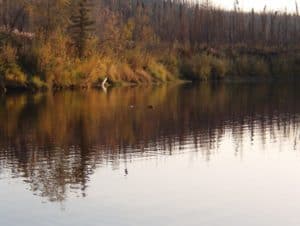
For Woodlands
If you’re traveling to a wooded area, the considerations will be similar. However, water will likely be much easier to come by. If you’re trying to build everything you need in a wooded area, the rule of threes still applies. You need a hatchet or an ax to cut branches. You will want to build a lean-to as quickly as possible. You likely won’t need a poncho to build a lean-to in the woods either.
If you build your lean-to with branches, you can then use the largest leaves or boughs you can find to lay over the branches. That will help keep the rain off of you. You want to make sure that the lean-to is leaning against the direction the wind is blowing.
To start a fire in a wooded area, you need only your ax and a piece of flint. Sometimes, you can spark your ax against rocks that you encounter, but it’s easier if you have a flint. If it has rained recently, finding dry tinder can be difficult. One option is to run your ax across the surface of denim jeans. The cotton fluff that is pulled up by the ax is perfect tinder for sparks.
Look for branches that have died but are still connected to a tree or tangled in the branches. If they’ve been suspended off the ground, they are likely dry enough to light. The easiest test is to attempt to snap them. They should snap easily with no green inside.
Finding water will likely not be the problem. Water is usually fairly abundant in wooded areas; a stream or a pond is never too far away if you just follow game trails. However, the water might not be potable. Finding readily drinkable water in the 21st century is not always simple. You can boil it to purify it, filter it, or you can use purification tablets. Filtering the water removes bacteria and particulates, but not viruses.
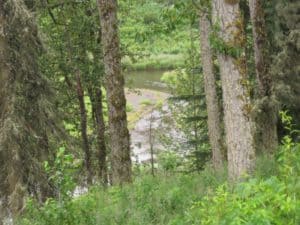
You’ll need a filter with iodine or chlorine to kill viruses. Purification tablets kill viruses and bacteria but do not remove physical contaminants. Finally, boiling kills viruses and bacteria but does not remove physical contaminants either. Also, boiling requires the largest use of fuel. You can read more about water purification options here.
However, if you’ve already built a fire at your shelter, boiling your water could be an option. For boiling, you need a vessel. You need something that can withstand the heat of the fire without burning itself. If you’ve carried a metal pot or metal bottle with you, then you can set that directly into the fire.
However, the point is to build as much as possible. If you can’t find a shell or a rock that is bowl-shaped and will survive going into a fire, you need to bring the fire to the water. Build a fire and place stones in the hottest part of the fire.
You should then collect water in whatever vessel you can find, such as a large leaf. Once the stones are incredibly hot, use a t-shirt or long branches to pull the stone out of the fire and drop it into the water. You need to have enough stones to boil the water for at least a minute. Given the difficulty in doing this it is probably not going to be what you plan on doing buy rather a backup plan. Read more about heavy duty camp ovens.
Woodlands Summary
In a woodland climate, you will need to find shelter, water, and food. To do that, you will need a hatchet or an ax. A poncho or mylar blanket would be useful again for this, but you can also use wooden boughs. A flint is useful for striking sparks with your ax. You’ll also need some way to purify your water. A filter with iodine or purifiation tablets are great choices. If you’re trying to bring as little as possible on the trip, you will need to purify the water by boiling it.
For food, you will need some kind of guide to local plants. You could bring one with you or you could study up. It’s suggested to bring one with you because certain poisonous plants might resemble edible plants.
The Final List
In summary, the tools that you need for dry climates are similar to the tools you need for wetter climates. A dry climate will make finding water more difficult but the weather will likely be less of a hassle. A wetter climate will have readily available water, but you’ll need to make sure you can keep the rain off of you.
You’ll need to build a shelter wherever you go; a lean-to is the easiest one to build. You can build this shelter using cut tree branches or your own poncho. You’ll need to build a fire as well. In the drier climate, you’ll have a difficult time finding large pieces of wood for your fire, but they’ll likely be drier. In the wetter climate, you’ll be able to find wood but dry wood will be a little harder to come by.
The easiest food will be local plants. Look for birds in the morning and the evening; they usually circle food sources and sources of water.
- Hatchet or ax
- A way to purify your water
- Research on local plants
- Flint
- Poncho, tarp, or waterproof blanket
If you have these five things, you will be able to make anything you need for surviving in dry climates as well as wet climates. Even if you bring more than that on your camping trip, it’s nice to know that you can survive with just those things for a while. This knowledge will come in handy on camping trips, if you get lost hiking, or if you just want to test your limits.
Author Bio:
My name is Nigel William. I have a website – Toolazine where I write about the various topics of interest to me such as camping, survival, gardening, DIY home improvement, woodworking among other things.

